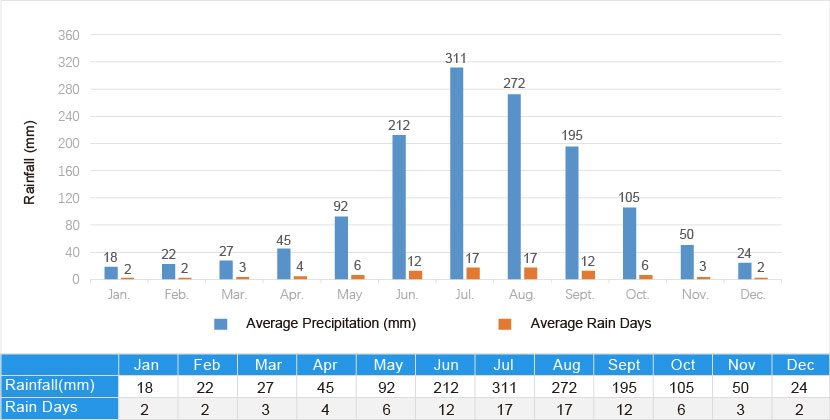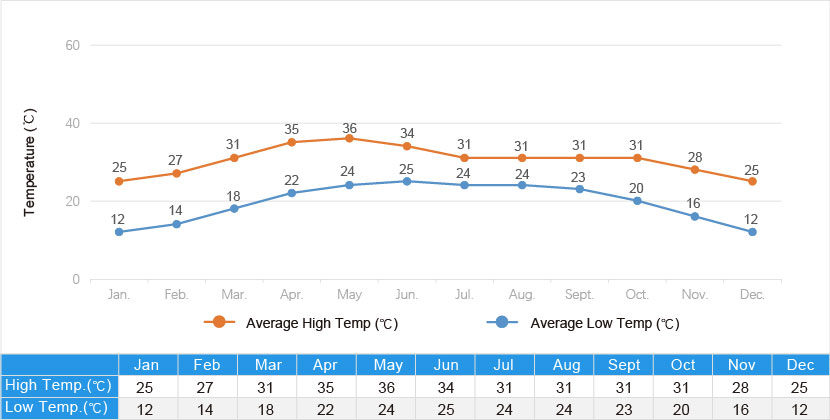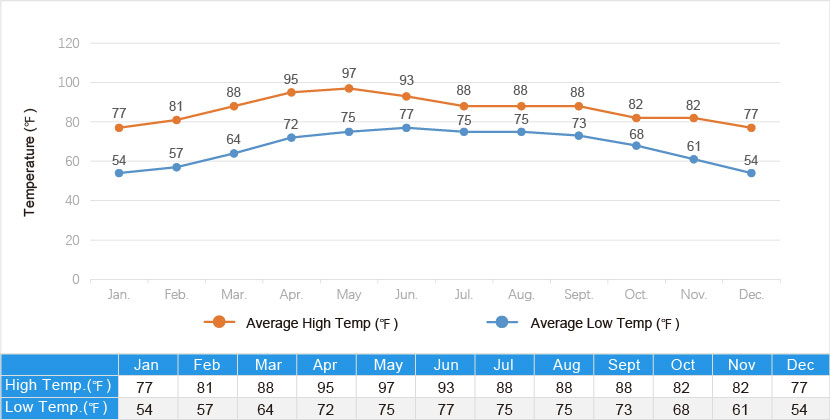India Weather
Facts of India Climate & Weather
Most parts of India feature typical tropical monsoon climate and remains hot throughout the year. Under the influence of monsoons, India has three seasons: the cool season or winter; the hot season or summer; and the monsoon season or the rainy season.
When the northeast monsoon blows from inland to the sea, the hot season starts and the air is dry. It lasts from March to May, with extremely high temperature which is often over 40℃ (104℉).
When the southwest monsoon blows from the sea to the land, the rainy season starts. It lasts from June to October with a lot of moisture and rich rainfall. India’s most rainfall occur during the rainy season, accounting for about 80% of the annual precipitation.
When the monsoon fades in October, India welcomes the most comfortable time, the cool season or winter from November to February. The Himalayas just protects India from cold currents and thus no chill weather exists in winter. The temperature generally hovers around 12-28°C (54-82℉), remaining warm during the day but cool at night.
Best Time to Visit India
The best visit time differs slightly in different regions. For beach lovers, it is recommended to avoid the rainy season and the best time to have fun on Goa’s beaches is always between December and March. However, for hikers and trekkers, the best time to explore the Himalayas mountainous areas is June to November.
| Month | Travel Recommendation | Season | Average Temperature |
|---|---|---|---|
| January | Cool Season | 12-25°C (54-77℉) | |
| February | Cool Season | 14-27°C (57-81℉) | |
| March | Hot Season | 18-31°C (64-88℉) | |
| April | Hot Season | 22-35°C (72-95℉) | |
| May | Hot Season | 24-36°C (75-97℉) | |
| June | Rainy Season | 25-34°C (77-93℉) | |
| July | Rainy Season | 24-31°C (75-88℉) | |
| August | Rainy Season | 24-31°C (75-88℉) | |
| September | Rainy Season | 23-31°C (73-88℉) | |
| October | Rainy Season | 20-31°C (68-88℉) | |
| November | Cool Season | 16-28°C (61-82℉) | |
| December | Cool Season | 12-25°C (54-77℉) |
 |
Regional Weather of India
Northern India – Delhi, Agra, Jaipur, the Himalayas
Southern India – Mumbai, Bangalore, Chennai, Goa
![]() Major Destinations: Mumbai, Bangalore, Chennai, Hyderabad, Goa, Kerala…
Major Destinations: Mumbai, Bangalore, Chennai, Hyderabad, Goa, Kerala…![]() Weather Review: Surrounded by the Arabian Sea and the Indian Ocean, Southern India has more tropical weather features and higher temperature and humidity can be expected. The temperature ranges about 18-34℃ (64-93℉). Generally, there are 4 seasons: the winter from December to February, the summer from March to May, the rainy season from June to September, and the post-monsoon season between October and November.
Weather Review: Surrounded by the Arabian Sea and the Indian Ocean, Southern India has more tropical weather features and higher temperature and humidity can be expected. The temperature ranges about 18-34℃ (64-93℉). Generally, there are 4 seasons: the winter from December to February, the summer from March to May, the rainy season from June to September, and the post-monsoon season between October and November. ![]() Travel Recommendation: There is no doubt that the best time to visit Southern India is the winter from December to February when the weather is mild and dry. Travelers can appreciate the stunning skylines and gorgeous colonial buildings in Mumbai, explore bars and pubs in Bangalore, and enjoy the warm sunshine on Goa's fine beaches.
Travel Recommendation: There is no doubt that the best time to visit Southern India is the winter from December to February when the weather is mild and dry. Travelers can appreciate the stunning skylines and gorgeous colonial buildings in Mumbai, explore bars and pubs in Bangalore, and enjoy the warm sunshine on Goa's fine beaches.
Cyclone Season in India
India’s east regions and coastal cities are vulnerable to being attacked by cyclones which generally land in the months of May-June and October-November. Visitors should pay close attention to the real-time weather forecast if visiting during the period.
 C
C
